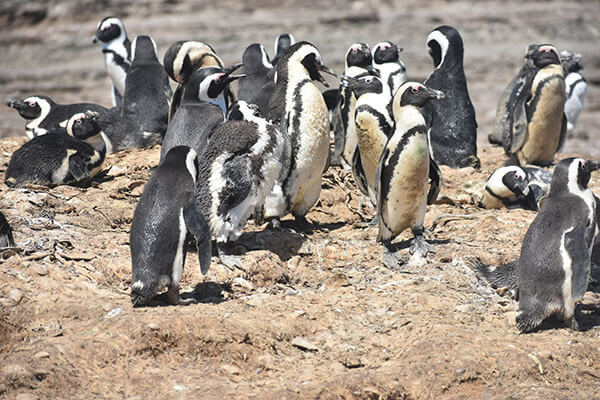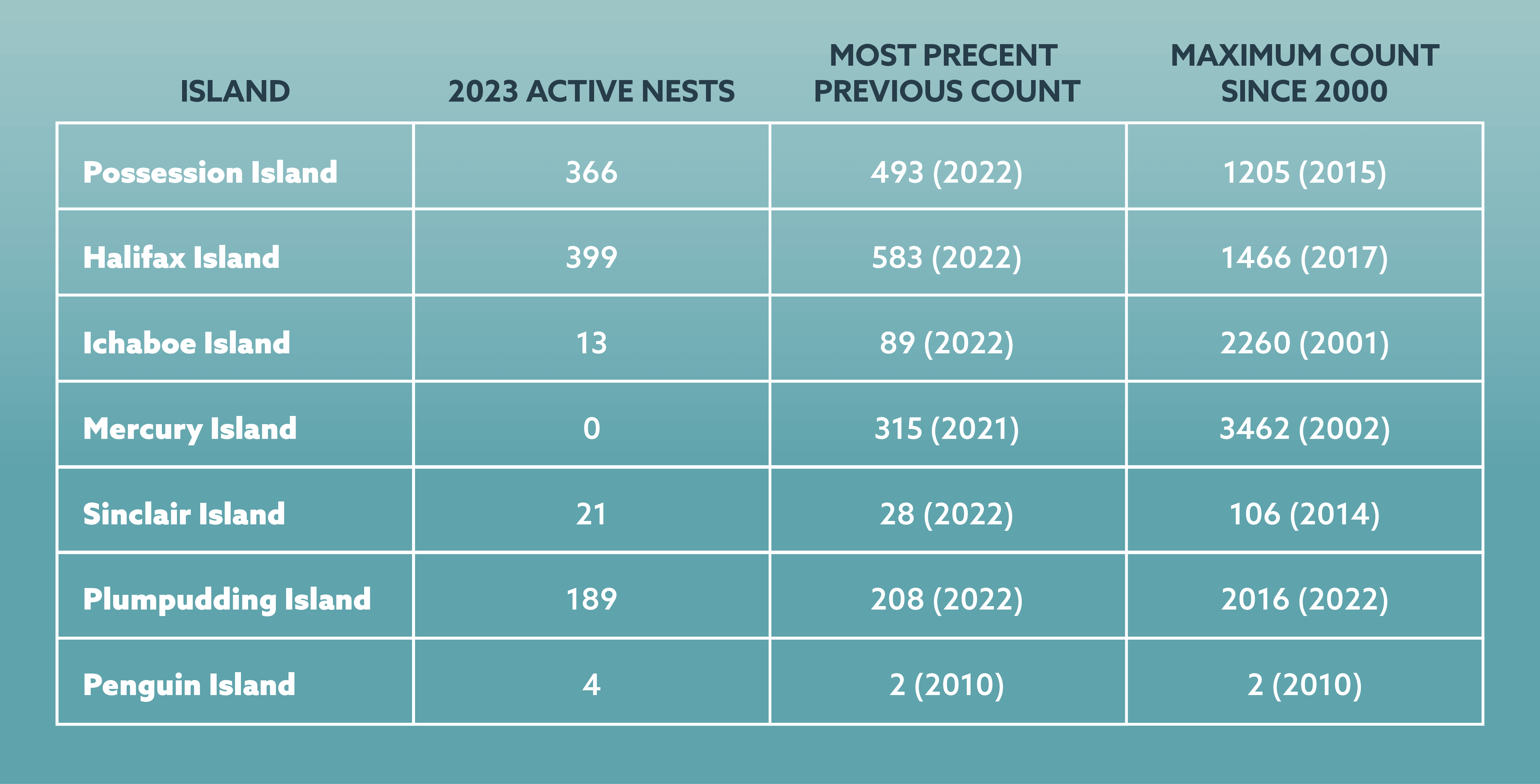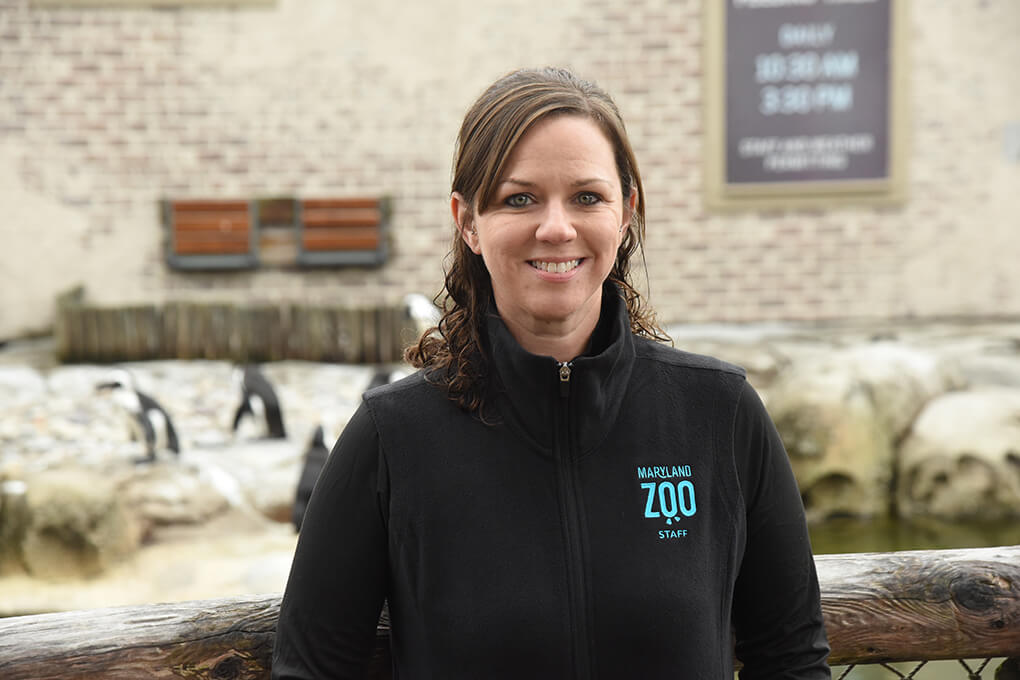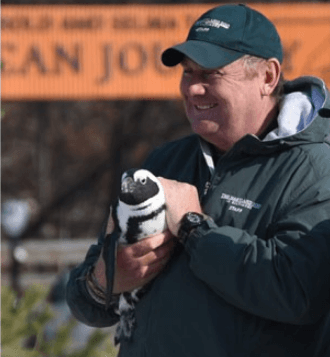In early 2023, we wrote about African penguin conservation and a nascent seabird rescue center taking shape in Luderitz, a rugged port town in southern Namibia.
Since then, there is a lot of progress to report, albeit amid increasing concern about the colonies of black-footed penguins living on the 20 or so islands that dot the western coast of Namibia and neighboring South Africa.
This spring, as Maryland Zoo’s award-winning Penguin Coast turns ten years old, we want to update you about the changing status of this beloved species and our ongoing work to save the birds in their native range.
A World Away
Getting to Namibia’s southwestern coast is a test of endurance. From Dulles International, take an eight-hour flight to Frankfurt, Germany where, upon landing, you have an eight-hour layover before flying 10.5 hours to Windhoek in Namibia.
After more than 26 hours of air travel your destination is still a ten-hour drive away, winding hundreds of miles through a barren landscape of sand, stone, and little else. The epic journey ends in a frontier town that, despite some vibrant architecture, perches on what’s been described as, “one of the least hospitable coasts in Africa.”
The rugged shoreline is dotted by islands that are home to the world’s only wild population of black-footed penguins. What happens on, and around, these islands will determine the fate of this species in the wild, which makes them the ultimate destination for Jess Phillips, a seabird expert and Director of Animal Facilities at Maryland Zoo who has been making conservation trips there for years.


Maryland Zoo has long been involved in seabird rescue at SANCCOB (the Southern African Foundation for the Conservation of Coastal Birds). Through the work there, our team saw, first-hand, how global warming, oil spills, and over-vishing are negatively affecting the penguin population. This made Phillips wonder about the birds farther north.
“Pretty much from day one of starting this position I was curious about what was going on in Namibia,” Phillips said. “I would ask about the penguins there, and none of my contacts in South Africa really seemed to know, so I thought we should find out.”
He did much more than that. Phillips developed a coalition of conservationists, government officials, and funders that, together, are building a seabird rescue center in Namibia based on the SANCCOB model.
Ranger School
Creating a new facility and the organization behind it is a massive undertaking. The list of needs is great, the funding demands are many, and, even on the best day, marshaling partners and resources across multiple continents is daunting. None of that deterred Phillips and, as we reported last year, his perseverance led to a new non-profit, non-governmental organization (NGO) named NAMCOB that officially launched in February of 2023. Fittingly, Phillips was elected to the Executive Board.
Maryland Zoo is a founding member along with SANCCOB, the Debmarine-Namdeb Foundation, Namibian Chamber of Environment, Namibia Nature Foundation, and the Namibia-based African Penguin Conservation Project, among many others.
This past fall, NAMCOB got to work finding three seabird rangers who will protect the colonies on the islands. In addition to a biology- or conservation-related degree, the ideal ranger candidates will need a true passion for conservation work. That’s what it will take to endure the often grueling and lonely conditions that come with living on the islands for three weeks at a time.
“We can teach them about seabirds, but they have to bring their own motivation and appreciation for this work,” Phillips said. “We included a trip to the islands as part of the interview process to make sure the candidates know what they would be getting themselves into.”


Out of more than 300 applicants, five made the cut. In November of 2023, Philips, Dr. Katta Ludynia from SANCCOB, and Rodney Braybury from the Namibian Nature Foundation escorted them to two islands aboard a vessel owned by the Namibian Ministry of Fisheries and Marine Resources. There, the candidates experienced, first hand, what it would be like to live and work in such barebones conditions.
From the group of five, three were hired and began work early this year with a four-week training at SANCCOB before transferring to Luderitz – their launch point for monitoring the offshore colonies.
Getting the rangers out in the field as quickly as possible was important to the NAMCOB team. As they suspected, but would soon confirm with unsettling clarity, time is not on the birds’ side.
Swimming Against the Tide
After the ranger candidates left Luderitz, Phillips and Dr. Ludynia joined the Namibian Ministry of Fisheries staff to perform a census of the penguin colonies that are a part of the Namibian Islands’ Marine Protected Area (NIMPA).
To effectively measure the number of breeding pairs, the census counts active nests – an important indicator of future colony health – not individual birds.
“Counting nests shows you what’s really going on in terms of population management,” Phillips said.
This was the first bird count during peak breeding season since 2019. (There had been informal counts on the islands in 2021 and 2022 but they weren’t during breeding season and, therefore, considered less than ideal.)
While it has been well known that the colonies are in decline, the 2023 census documented an alarming drop in the bird population. For example, just a year ago, we wrote about Mercury island as, “a loud and bustling bird breeding ground,” supporting, “by far the largest colony of African penguins in Namibia.”
After his recent visit there during the census, Phillips describes Mercury as the colony with the biggest decline. “We counted 75 penguins total but there were only two active nests.”
The final census report described the findings on Mercury Island this way:
The visit to Mercury Island was shocking, especially after having visited the island over a period of ten years in the early 2000s, when the island was home to over 50% of Namibia’s African penguin population (with over 3000 breeding pairs), around 80% of the world’s bank cormorant population (with over 2200 breeding pairs) and the second largest Cape gannet colony in Namibia (3600 breeding pairs). All three of these species are listed as Endangered by the IUCN.
This table shows the number of active African penguin nests counted since 2000.

“It was pretty shocking,” Phillips said. “We found desolate, empty areas where before you’d seen hundreds of birds. This is a wakeup call that we need to be even more proactive.”
“The fact that we’re already getting rangers out to the islands ASAP means we can rescue sick or injured juveniles and adults to help them survive when they may not, otherwise. This will have a big impact on the population,” Phillips said. “But it also speeds up the need to build the seabird rescue center back on the mainland, which will allow us to rescue eggs and chicks.”



The Species Survival Plan
Maryland Zoo’s Bird Curator, Jen Kottyan, has been appointed to lead the national breeding and population management initiative for African penguins (Spheniscus demersus).
As the Program Leader for the African Penguin Species Survival Plan© (SSP), Kottyan now oversees African penguin breeding programs at zoos accredited by the Association of Zoos and Aquariums (AZA).
Kottyan has been working with the SSP for some time and relocated to Maryland Zoo in June 2008 specifically to work with the Zoo’s colony of African penguins.
“Anyone who’s interacted with the African penguin colony at our Zoo knows how incredible these animals are,” Kottyan said. “Because of the decreasing populations in the wild, the work of the AZA’s African Penguin SSP Program is more critical now than ever.”
Coming Together
Maryland Zoo experts have been working under the knowledge that African penguins could be extinct in the wild within a decade. The recent bird count has only strengthened our resolve.
Getting NAMCOB established and the rangers hired were vital first steps. As of this writing, an international search for NAMCOB’s first Director was underway. Earlier this year, the organization held its first Annual General Meeting. Land has already been acquired and architectural drawings are being readied for the Luderitz seabird facility where local staff and international experts will work alongside the Ministry of Fisheries and Marine Resources, along with a complimentary host of foundations and other NGOs, to monitor the colonies, protect habitat, ensure disaster preparedness, and promote community engagement and education in the surrounding area.
To fund this work, the Namibian Nature Foundation secured a roughly $3 million grant from the Blue Action Fund in 2023 to cover NAMCOB operating costs through the first five years. This includes staffing up, purchasing vehicles and a vessel, and outfitting office space.
The coalition of other conservation partners is long and includes the Association of Zoos and Aquariums (AZA) Saving Animals From Extinction (SAFE) program for African penguins, which supported the ranger candidates’ travel to Luderitz and initial island colony visit.
As soon as possible, rangers will rehabilitate dilapidated buildings where they will live and work on the islands – structures that date back to guano harvesting operations in the early 1900s. Tools, such as ground readers that help track penguin movements using transponder tags, and solar panels have already been deployed to monitor the colonies on Halifax island.
Back at home, Maryland Zoo’s Bird Curator, Jen Kottyan, has begun leading the AZA’s African Penguin Species Survival Plan© (SSP), which oversees breeding and population management (see inset box). The hope is that, once conditions in Namibia and South Africa are more hospitable, the birds in AZA-accredited zoos will parent new generations of penguins in the wild.
Educating the public about penguin conservation is an important part of our mission. Everyone who visits our campus or schedules a Penguin Encounter learns about the colony in Baltimore and our efforts to save their brethren in the wild.
Off campus, the Zoo’s 2024 marketing campaign connects millions of people to the importance of penguin conservation. And, in a popular rite of spring, we introduce new penguin chicks to the public through naming contests, social media posts, and a partnership with a local retail group, Route One Apparel, that’s raising both awareness and valuable conservation funds.


“There’s no time to spare when the clock is ticking for these amazing birds,” said Maryland Zoo President & CEO, Kirby Fowler. “I’m proud of Maryland Zoo’s role in the creation of NAMCOB and the positive impact it will have, not just on African penguins but on the wide array of seabird colonies that live off the coast of Namibia.”
Fowler adds, “I’m also in awe of the dedication and passion that drives our conservation teams to consistently go above and beyond for the sake of wildlife and wild places.”
An embodiment of that passion, Phillips is gearing up for another trip to Luderitz in the summer of 2024 to help run NAMCOB while the search for a permanent director continues.
“I’ve made contacts down there and know people who will help me get NAMCOB established, including strong relationships with governmental agencies.” Phillips said. “It’s good to be down there prodding to get things done.”
“I’m excited to see NAMCOB develop and I do feel, honestly, that I can help protect these island colonies and build a strong connection between the center and the surrounding community.”
 BACK TO STORIES
BACK TO STORIES
 MORE ZOOGRAM STORIES
MORE ZOOGRAM STORIES